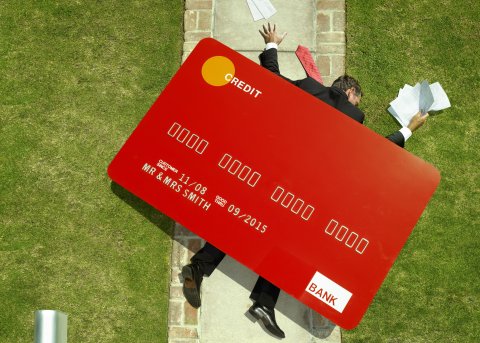That queasy feeling you got last month after you overindulged at a holiday party or knocked back one too many glasses of bubbly on New Year's Eve? Chances are you may suffer a similar sensation this month when your credit card bills show up—stark proof of the toll your holiday travels, entertaining and generosity are taking on your finances.
Plenty of people share your pain. The typical consumer racked up more than $1,300 in debt over the holidays, according to a MagnifyMoney survey, with Gen-Xers owing the most, at $2,076 on average. Compounding the problem: Seven in 10 borrowers already had a balance on their credit card before the giving season began.
"It isn't splurging for that one big, expensive gift—the car with the bow in the commercials—but all of the hundreds of small, seemingly insignificant transactions that you don't appreciate until the credit card bill comes," says Bill Engel, a financial consultant at wealth management firm Fort Pitt Capital Group. "All of a sudden you owe two to three times more than you thought."
Paying down that debt can get expensive—and stressful. Most borrowers say they'll need a few months or more to whittle their balance down to zero, according to Magnify Money, and the average financing rate on a credit card is 17 percent. Store cards, used by a fifth of holiday shoppers, are even worse, with an average rate of more than 25 percent. No wonder nearly six in 10 consumers admit they're stressed out about what they owe from the holidays.
That's no way to start a New Year. If you've given your favorite credit card too much of a workout lately, these simple moves will help get your finances back on track.
Put spending on pause
Just as abstaining from alcohol during a "Dry January" can improve your health, so you can get your finances in better shape by pledging not to buy anything but essential goods and services during a "No-Spend January." If foregoing concert tickets and eating out for a month proves less painful than you imagined, you might even stretch it into a frugal February. This is a two-fer strategy: Not only will you make room in your budget to pay down debt, you'll also break yourself of last month's spending-spree mentality.
Too draconian? Look for more targeted places to free up cash to put toward your credit cards. A prime target: monthly revolving subscriptions, like Netflix and Audible. According to the business consultancy firm West Monroe Partners, Americans dole out almost $250 a month on such fare, and almost nine in 10 consumers underestimate their cost.
If you're among the more than half of shoppers who save their credit card information on retail websites, also delete your credentials from the Amazons of the world, at least for a month or two. By making an impulse purchase more irksome, you reduce the chances you'll actually buy it and rob yourself of money you can put toward debt.
Make windfalls work for you
The beginning of the year is typically when companies hand out bonuses for the previous year's work and early-bird tax filers get their refunds (average 2019 payout: $2,860). Turn that influx of cash into a shield against red ink rather than viewing it as a license to buy a new jet ski.
Matt Becker, a financial planner in Gulf Breeze, Florida, encourages his clients to use cash infusions to pay down debt, as well as to add "25 percent to 50 percent of their annual raise to automatic monthly debt payments, prioritizing the highest-interest debt first."
You can also redeem rewards you've accumulated on your credit card as a statement credit to reduce your balance. Almost a third of cardholders never use their points, a Bankrate survey found. Enjoy the irony: You'll be using rewards at least partly amassed from holiday spending to pay off those same bills a month or two later.

Cut your interest to zero
If you'll need more than a month or two to wipe out your debt, a balance transfer card can sharply reduce your cost of borrowing, enabling you to put more toward principal and pay off what you owe faster. These cards typically offer a set period during which you pay no interest on the amount you shift to them from another credit-card account, often 12 months or more. There's usually a fee, generally 3% of the balance you move over. To be approved for the cards, the Consumer Federal Protection Bureau found you'll typically need a credit score of 660 or higher.
Some issuers waive the fee entirely or offer an unusually long interest-free payback period (say, 18 months or more), but it's almost impossible to find both features in a single card. One option that comes close: the Chase Slate, which offers an introductory period with 15 months of zero-percent interest on balances you transfer within 60 days of opening the account. Similarly, the Amex Everyday offers 15 months of zero-percent interest with no annual fee and no balance transfer fee.
To get a longer no-interest period, however, you'll have to pay a balance transfer fee. Among the best of these offerings: the Citi Double Cash, which has a relatively low balance transfer fee ($5 or 3 percent of the amount of each transfer, whichever is greater) and an 18-month interest-free payback period and no annual fee.
Focus your efforts
If you charged holiday purchases on more than one credit card, don't spread payments evenly among them. Research shows that borrowers feel inspired to retire debt more aggressively when they prioritize payments on one card until it's paid off, making only minimum payments on the rest, before they move on to paying off the next one.
You can either focus on cards in order of how much interest they charge (from highest to lowest) or by the size of your balance (from smallest to largest). The former will save you the most money in interest payments. But studies show the small-to-large-balance payoff strategy, commonly called the snowball method, typically provides a greater sense of progress, which in turn helps motivate borrowers to stick with the program until they're debt free.
Think about next year
There's no time like the present to make sure the 2020 holiday season isn't a repeat of 2019, when it comes to credit card debt. "The clients I've seen avoid trouble are the ones who plan ahead," says Becker. "They set up a dedicated 'holidays' savings account with an automatic monthly contribution that runs year round."
While Christmas clubs may seem passé, they're actually genius. All you need to do is open a separate savings account and dedicate a small percentage of your paycheck to fund it. Say you earn $70,000 annually, and expect to spend around $700 on gifts, parties and the like next year. Simply sign up through your employer's direct deposit or via a financial services company to have 1 percent of your pay automatically directed into a "festivities fund"—the amount taken out will be so small you'll barely feel it—and you'll enter next winter solstice free of money anxiety.
Worried that you might dip into that honey pot before the holiday season arrives? The website Stickk.com, created by behavioral economists, has tools to help you stick to your savings goal, including ramping up the stakes by having you commit to donating to an entity (like a charity or your worst enemy) if you fail to hit your target. The hope is that the pain of losing money is worse than meeting your savings goal. If you don't want to be that dedicated, you can always make a side bet with a stickler friend or spouse who'll hold your feet to the fire.
Not only will you slash debt now, but the exercise will help you become more conscious of how much you're swiping your card when the 2020 holiday season rolls around—the proverbial win-win.
Taylor Tepper is a senior writer at Wirecutter Money and a former staff writer at Money magazine. His work has additionally been published in Fortune, NPR and Bloomberg. You can find him on LinkedIn, Twitter, and Instagram.














